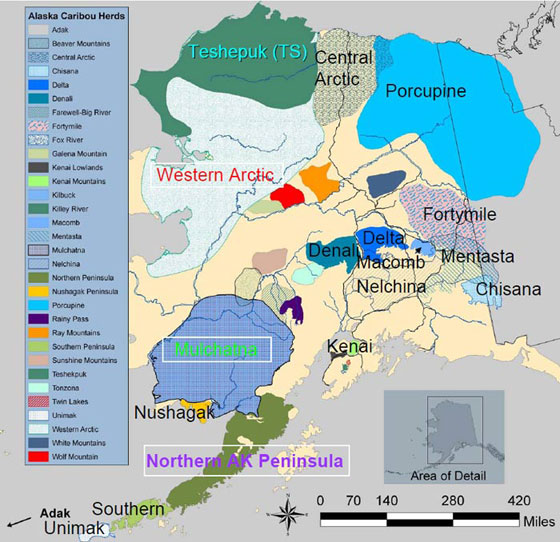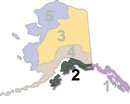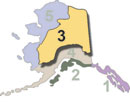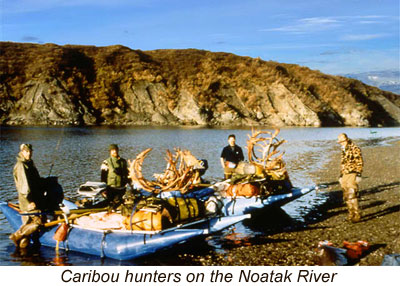Regal. Graceful. Perplexing. Stunning. All these terms and more can describe Alaska's barren-ground caribou. Widely-distributed from the Kenai Peninsula north, and out onto the Alaska Peninsula, caribou are majestic wanderers on whatever range they are found. Calving takes place in the month of May in most of the state. Calving frequently takes place in areas where lots of caribou are together; the many sets of eyes, ears, and noses are a huge asset in detecting wolves and bears, the two chief predators of caribou calves.

To a hunter, the antlers of a bull are the most visible feature. They're perhaps the most impressive antlers of any of the deer species. It's been said that no two bulls grow antlers that are the same. There is a lot of variation in configuration from one bull to another. Some have many points and little palmation, while others sport palmated tops, palmated bez tines, and double shovels. Preliminary scoring of a caribou on the hoof is nearly impossible because there are so many variables to consider. Look for a bull with lots of antler length; long main beams, long antler points, twin shovels, and long back points. Of course, as with all deer species, symmetry is critical to a good score. But any professional scorer will agree that caribou are the hardest of all to judge on the hoof.
Some regions tend to produce larger animals than others. Arctic caribou from any of the several herds up there are generally smaller-bodied and have smaller antlers than those farther south. Adak caribou are probably the largest-bodied and largest-antlered of any of Alaska's caribou. See our Adak Caribou Hunting page for specific details on this unique herd and how to hunt them.
Seasons
Subsistence hunting may take place year-round, however, the sport season usually begins in August and ends at the end of September. Rut activity begins in mid-September and actual breeding takes place in October. As the rut approaches, mature bulls develop a white mane and may develop a black band bordered by two white or gray stripes on each side of the animal.

Regions and Methods
Caribou are distributed over much of Alaska, and many herds intermingle at times, making the task of pinning them down to a specific location challenging. Here's an overview of caribou distribution in Alaska.

The above map is from the Alaska Department of Fish & Game, and it shows the general location of Alaska's 32 caribou herds. It should be noted that the boundaries of these herds is somewhat fluid, as caribou wander ceaselessly, sometimes moving in and out of places unexpectedly. Fresh research is essential in determining the likely location of animals during hunting season. The best place to start with that is a call to the local area biologist for the location in question.
Region 1 (Southeast Panhandle)
Game Management Units: GMU 1, 2, 3, 4 & 5
Region 1 South: Southeast Panhandle | Region 1 North: Yakutat / Cordova Area
Available species:
Black Bear | Brown / Grizzly Bear | Deer | Elk | Goat | Moose | Wolf
There are no caribou in Region 1.
Region 2 (North Gulf Coast, Kenai Peninsula, Kodiak / Afognak Archipelago)
Game Management Units: GMU 6, 7, 8, 14C, 15
Region 2 East: North Gulf Coast / Kenai Peninsula | Region 2 West: Kodiak / Afognak Archipelago
Available species:
Bison | Black Bear | Brown / Grizzly Bear | Caribou | Dall Sheep | Deer | Elk | Goat | Moose | Wolf
There are four caribou herds on the Kenai Peninsula; the Kenai Mountains Herd, Kenai Lowlands Herd (closed to hunting), Killey River / Twin Lakes Herd, and the Fox River Herd (also closed to hunting). Caribou hunting on the Kenai Peninsula is by permit only.
The Kenai Mountains herd is located in GMU 7. Hunters can access this herd north of the Sterling Highway and west of the Seward Highway; specifically near Big Indian Creek off of the Resurrection Pass Trail. Access is difficult and often involves long hikes on established hiking trails that run for miles into the country. A solo backpack hunt for Kenai Mountains caribou is at the extreme end of the difficulty scale, as the animal will need to be packed out in a minimum of two loads. Some fly-out hunts are possible, however, landing areas are limited. Charter arrangements can be made out of Anchorage or the Kenai area. The season opens generally in the second week of August and lasts through the month of December. Hunting pressure is light and trophy potential is high.
and west of the Seward Highway; specifically near Big Indian Creek off of the Resurrection Pass Trail. Access is difficult and often involves long hikes on established hiking trails that run for miles into the country. A solo backpack hunt for Kenai Mountains caribou is at the extreme end of the difficulty scale, as the animal will need to be packed out in a minimum of two loads. Some fly-out hunts are possible, however, landing areas are limited. Charter arrangements can be made out of Anchorage or the Kenai area. The season opens generally in the second week of August and lasts through the month of December. Hunting pressure is light and trophy potential is high.
The Kenai Lowlands Herd is located in GMU 15 (Subunits 15A and15B). In past years, a few permits were issued annually for this hunt. However, hunting was closed in the late 1990s because of a declining population (at that time around 150 animals).
The Killey River/Twin Lakes Herd is located in GMU 15 (Subunit 15B). Hunting opens the second week of August and closes the third week of September. Hunters can access the herd from the Kenai National Wildlife Refuge Wilderness Area. Because the refuge is closed to off-road vehicles and only allows limited aircraft use, horses are are a good access method. Because of limited access, the trophy potential for his herd is high.
The Fox River Herd is located in GMU 15 (Subunit 15C). In past years, 10 permits were issued for this hunt. However, hunting season was closed in 2004 due to population decline (around 100 animals at that time).
Region 3 (Interior, central & eastern Brooks Range)
Game Management Units: GMU 12, 19, 20, 21, 24, 25, 26B, 26C
Region 3 East: Eastern Arctic / Eastern Interior | Region 3 West: Central Interior
Available species:
Bison | Black Bear | Brown / Grizzly Bear | Caribou | Dall Sheep | Moose | Wolf
This area contains several herds located in completely different and often isolated ecosystems. Most are managed separately and in some cases, numbers are low enough to warrant permit hunting only, which is tightly regulated. Closures can occur with little notice, therefore it is in the best interest of hunters in these areas to carry a satellite phone in order to contact the appropriate ADF&G office as needed, to determine the status of any closures.
GMU 12, 20D: The Macomb Plateau contains a small herd that is managed on a permit basis. Details on the hunt can be found AT THIS LINK. GMU 20D is also home to portions of the Fortymile Herd, listed below.
GMU 19: This area contains the Big River Herd and scattered herds located between the Mulchatna River in the south, to the North Fork of the Kuskokwim River in the north. This is the former grounds of the Mulchatna Herd (MCH), which peaked at around 200,000 head in 1996, followed by a spectacular crash shortly thereafter. The cause of the rise and fall of the MCH is not understood even by biologists assigned to the area, however, at the time of the crash, specimens were found with hoof rot, which has been identified with weather-related habitat degradation.
GMU 20B, D, E, 25C: The Fortymile Herd moves in an east-west migration pattern, coming in and out of Canada. In Alaska, they can be found in the area bordered by the Alaska Highway from the Canadian border to Fairbanks, north along the Steese Highway to Circle, and east from Circle to the Candian Border). The area is divided into zones that are managed separately. Portions of each zone are open or closed by the Alaska Department of Fish and Game as needed for management purposes. Closures are in effect when harvest quotas have been reached. These closures can happen at any time, and hunters are advised to call the Fortymile Caribou Hotline at 1 (907) 267-2310 for details on openings and closures. Maps describing the boundaries of the three zones can be found AT THIS LINK.
GMU 20B, F, 25C
GMU 20B, F, 25C: The White Mountain herd is located in this area, but numbers are low enough to warrant a permit hunt.
GMU 21: Portions of the eastern edge of GMU 21 have limited numbers of caribou, which are available on a general season tag. Numbers are somewhat higher in the western portion of the unit, in the Nulato Hills area west of the Yukon River.
GMU 24: GMU 24A is bisected by the Dalton Highway (the Haul Road), and contains habitat frequented by the Central Arctic Herd.
GMU 25: This area hosts the Porcupine Herd as it makes its circuitous route east and west to and from Canada's Richardson Mountains, through the Porcupine River country, and into Alaska's eastern Brooks Range. Movement patterns are unpredictable, however, caribou can be generally found in the headwater areas of several drainages in the north end of GMU 25, and over the divide in the southern portion of GMU 26C. Portions of the Central Arctic Herd are found in the vicinity of the Haul Road, on the western edge of GMU 25A and in GMU 24A.
GMU 26B, C: This area hosts two of Alaska's herds. The Central Arctic Herd lives in the central portion of Unit 26B and is typically accessed via aircraft or foot traffic originating from the Haul Road. Hunters are prohibited from discharging firearms within five miles of the road, so rifle hunters are in for an arduous hunt if they intend to hike outside the pipeline corridor. Those who are new to Alaska or inexperienced in navigating tundra on foot with heavy loads often overestimate their capabilities regarding this hunt. The ground is soft, wet muskeg underlaid with permafrost, which prohibits meltwater from leaching into the ground. Water remains in the soil and contributes to its spongy texture. Though the hike is "only" five miles, most hunters refuse to go back after packing several heavy meat loads through the area.
The Porcupine Herd is found in the eastern end of the area, typically east of the Canning River, where it moves in and out of Canada's Porcupine River country and east to the Richardson Mountains. Though caribou may be found out on the coastal plain, better hunting is usually found higher in the mountains near headwater areas.
Notes on the Porcupine Herd
The Porcupine Herd spends most of its time in Canada's north country, migrating from east to west into Alaska at times, before making its way back into Canada. This movement typically occurs during August and September. They can cross the border into Alaska anywhere from the town of Eagle, north to the Beaufort Sea. Typically they move across in the area north of the Porcupine River, and may be found in the upper reaches of the Coleen, Sheenjek, and Kongakut Rivers during hunting season. Check with your air charter for specific details and movement patterns just prior to your hunt. Canada maintains a website, titled, "Porcupine Caribou Herd Satellite Collar Project", where caribou from the PCH were collared and tracked electronically. The data were put on maps on this site, however, the Porcupine Caribou Herd Management Board, in the interest of offering a measure of protection for these animals, has requested that the active maps be taken down. The site remains a good reference on the PCH, however, so if you are hunting that area, be sure to take a look.
Region 4 (Southcentral, Alaska Peninsula, Aleutians)
Game Management Units: GMU 9, 10, 11, 13, 14A, 14B, 16, 17
Region 4 East: Southern Interior, Anchorage, Susitna Valley | Region 4 West: Bristol Bay and the Alaska Peninsula
Available species:
Bison | Black Bear | Brown / Grizzly Bear | Caribou | Dall Sheep | Goat | Moose | Wolf
This area harbors several herds of interest to hunters. The Alaska Peninsula has historical references to caribou inhabiting the area for as far back as written records can be found, however, the introduction of reindeer to the area around the turn of the century has, in the opinion of some, doomed the native caribou. Numbers have slipped dramatically from the tens of thousands of animals once found there. Naturalist Olaus Murie provided some background on the history of caribou and reindeer on the Alaska Peninsula and related islands in the Aleutians in his report for the Department of the Interior, which can be found AT THIS LINK.
GMU 9: Unit 9 contains the Northern Alaska Peninsula Herd, which has suffered from reduced numbers for the last few years. Currently, the only area open to hunting is in the Alagnak River drainage, in portions of GMU 9A, B & C.
GMU 10: Umnak Island and Atka Island both host huntable populations of reindeer which were introduced from Siberia in the early 1900s. It is possible that the animals found on Umnak are a result of interbreeding between native caribou and reindeer. Both herds are hunted on a guided basis, and access is difficult for the general public.
Adak Caribou The best caribou hunting in GMU 10 can be had on Adak Island, where the animals were introduced from the Nelchina Basin in the late 1950s. Details about hunting Adak are listed on our Adak Caribou Hunting page.
GMU 11: There are no caribou in this area.
GMU 13: Unit 13 is home to the Nelchina Caribou Herd, which is managed on a drawing permit basis. During hunting season most of the animals can be found in the heart of 13A, between the Denali Highway and the Glenn Highway. Many hunters use ATVs to access the area, however, aircraft are also used to access remote areas such as the Alphabet Hills. Some animals may be found in the Talkeetna Mountains in the south, and north of the Denali Highway as well. Because of its proximity to Anchorage, this is a very popular hunt and is often combined with a hunt for moose and/or grizzly bear.
GMU 14: Some animals from the Nelchina Caribou Herd spend the summer and early fall months in the Talkeetna Mountains, in portions of GMU 14B. The area can be difficult to access, however.
GMU 16: The western portion of GMU 16B contains scattered individuals and small groups of caribou from the Denali Herd and possible members of the Big River Herd, that slip over the Western Alaska Range from the McGrath side. There is also a herd inhabiting the Rainy Pass area, however, numbers are on a downward trend at this writing.
GMU 17: Unit 17B is the former heartland of the Mulchatna Caribou Herd, which saw a dramatic spike in numbers in the late 1990s and crashed soon afterward. Presently animals are scattered and few.
Region 5 (Western Brooks Range, west coast to Bristol Bay)
Game Management Units: GMU 18, 22, 23, 26A
Region 5 North: Western Arctic | Region 5 South: Yukon / Kuskokwim Delta
Available species:
Black Bear | Brown / Grizzly Bear | Caribou | Dall Sheep | Moose | Muskox | Wolf
GMU 22 & 23: The Western Arctic Caribou Herd (WACH) populates the north slope of the Brooks Range during the spring and summer months. Calving takes place on the Arctic Coastal Plain, and by late summer (August) calves are strong enough to begin the migration to wintering grounds to the south. Increased nonlocal hunting activity and fluctuations in caribou numbers and migration patterns have resulted in the creation of the Western Arctic Caribou Herd Working Group. Comprised of representatives of the native community, state biologists, sport hunters, guides, transporters, and conservationists, the stated aim of the group is "To work together to ensure the long term conservation of the Western Arctic Caribou Herd and the ecosystem on which it depends, and to maintain traditional and other uses for the benefit of all people now and in the future". This group produces several reports that are of interest to hunters. Hunters should read this information in order to make informed decisions about hunting this area.
Planning a caribou hunt in the western arctic involves consideration of the logistics of getting to the Arctic (currently Alaska Airlines is the only carrier offering jet service from Anchorage), the expense of chartering from Kotzebue to the hunting location (this area has some of the highest air charter fees in the state), and the fickle nature of the animals themselves (in recent years the migrations have not taken place until later in the season, with some areas not seeing any caribou at all until October).
Float hunters have a number of rivers to consider in this area, including the Kobuk, Noatak, Kelly, Kuguroruk, Selawik, and others. Visit our Rivers Page for more details.
Farther south in Region 5 lie the Nulato Hills, which run along the coast through Unalakleet and south to the Yukon River. The WACH has wintered in this area at times, and some caribou may be found there during winter, however, the area is of limited interest to sport hunters.
GMU 18: Few caribou are found in this area.
Hunting Tactics
Caribou are almost always on the move. Your job is to find a way to catch one. Not so easy if they are walking; a caribou's normal rate of travel is faster than most hunters can move. Especially over tundra, which is usually soft, spongy, and covered in tussocks. But caribou movements can be patterned. This is because between their hooves is an interdigital scent gland that deposits scent with every step. If an animal moves through an area, another can follow the exact same trail without ever seeing the first animal. So the real key is to hunt caribou with your head more than your legs. Observe the movement patterns of several herds before making a move to a point at which the next herd can be intercepted.
The second thing to understand about caribou is that they are a herd animal. But contrary to the mental picture most hunters have of vast herds that fill up the horizon, caribou most often travel in loose aggregations of small herds numbering from two or three animals to fifty or a hundred. These herds grow larger as the fall migration picks up, but most of the time you're looking for small groups. Because they are a herd animal that lives mostly in open country, approaching them can be difficult. This is why you must pattern them and locate a suitable ambush point that puts the wind in your favor while offering you a good shooting opportunity.
Because caribou are found most often in groups, it's important to remind yourself to look at what is downrange from the animal you intend to shoot. Careless hunters could easily shoot through an animal and hit another standing behind it. Make sure your animal is well clear of the herd before shooting.
Cows have antlers too! If you are hunting in a bull-only area, look for the penis sheath under the belly. Antlers are no guarantee that you're looking at a bull.
The Rut
Most male big-game animals develop a strong aroma during the rutting period. Though the animal has a strong scent, extra care taken during skinning and caring for the meat usually results in meat that is suitable for the dinner table. This is not true with caribou bulls. Rutted caribou meat is so bad a dog will not even eat it. This is because when bulls go through the rutting cycle they ingest hormone-saturated urine from cows. This liquid makes its way into the bloodstream, saturates the liver, and permeates the muscle tissue. Once the muscle tissue becomes saturated, the scent is so powerful that the meat cannot be eaten and must be thrown out.
The key to avoiding this situation is simple; don't shoot a bull that's in rut. But it's not that easy. The pre-rut activity starts as early as mid-September when many hunters are in the field looking for that trophy bull. The rut lasts until about the middle of October. So in theory, if you avoid shooting bulls between the last two weeks of September and the first two weeks of October, you won't shoot one that will end up in the dumpster. This is very difficult for trophy hunters, who may try to convince themselves that the bull they are shooting will be different. And they may be right; not all bulls exhibit this behavior. Some bulls shot during rut are fine eating. But because so many go through this cycle, ethical hunters will avoid taking chances with it.
Additional Resources
- On Caribou Hunting, by Duncan Gilchrist
- Alaska Field Care Manual, vols. 1 & 2, by Michael Strahan
- Hunting the Alaskan High Arctic, by Scott Haugen
- Hunting Caribou by Karyn Sharp and Henry S. Sharp
- Alaska Hunting Adventure (DVD) by Buck Nelson
- Season 2 The Modern Day Mountain Man by Billy Molls






